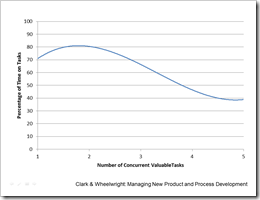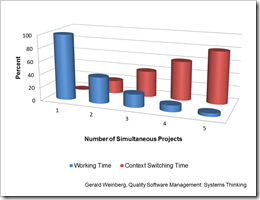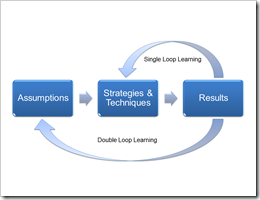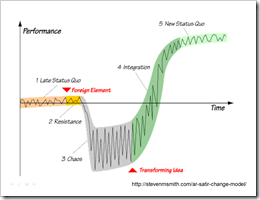This is the second part of a write-up of a talk I gave at a number of conferences last year. The previous post was the Introduction.
Software and systems development is acknowledged to be knowledge work, performed by people with skills and expertise. This is the basis for the Software Craftsmanship movement, who are focussing on improving competence, “raising the bar of software development by practicing it and helping others learn the craft.” A kanban system should, therefore, accept the human condition by recognising sciences such as neuroscience and psychology.
Visualisation
Neuroscience helps us understand the need for strong visualisation in a kanban system. Creating visualisations takes advantage of the way we see with our brains, creating common, shared mental models and increasing the likelihood that the work and its status will be remembered and acted on effectively.
Vision trumps all our other senses because our brains spend 50% of the time processing visual input. Evidence of this can be found in an experiment run on wine-tasting experts in Bordeaux, France. Experienced wine-tasters use a specific vocabulary to describe white wine, and another to describe red wine. A group in Bordeaux were given a selection of wines to taste, where some of the white wines had an odourless and tasteless red dye added. These experts described the tainted white wine using red wine vocabulary because seeing the wine as red significantly influenced their judgement. The same experiment has apparently also been run on novice wine-tasters who were less fooled, showing the danger of how experts becoming too entrained in their thinking.
Visual processing further dominates our perception of the world because of the way our brain takes the different inputs from each eye. For each index card on a board, instead of seeing two, one from each eye, the brain deconstructs and reconstructs the two inputs, synthesising them into a single image by making up and filling the blanks based on our assumptions and experiences. Thus what we end up with is a mental model created by the brain, and the kanban board helps that mental model to be one that is shared between the team.
The more visual input there is, the more likely it is to be remembered, en effect known as the pictorial superiority effect (PSE). Tests have shown that about 65% of pictorial information can be remembered after 72 hours, compared to only 10% of oral information. Visualising work status and other dimensions on a kanban board can, therefore, increase the chances of that information having a positive influence on outcomes.
Multitasking
Neuroscience also explains one of the benefits of limiting WIP; that of reducing multitasking.
Multitasking, when it comes to paying attention, is a myth. The important detail here is that it is when it comes to paying attention. Clearly we can walk and talk at the same time, but if we have to concentrate on climbing over an obstacle we will invariably stop talking. The brain can only actively focus on one thing at a time and studies have shown that being interrupted by multitasking results in work taking 50% longer with 50% more errors. For example, drivers using mobile phone have a higher accident rate than anyone except very drunk drivers. In other words, multitasking in the office can be as bad as being drunk at work!
Other studies have shown that effectiveness drops off with more tasks. In “Managing New Product and Process Development: Text and Cases” by Clark and Wheelwright show that when someone is given a second task, their percentage of time on valuable work rises slightly because they are able to keep themselves busy when they are blocked. However, beyond that, with each additional task the time spent adding value reduces.
Gerald Weinberg suggests similar results in “Quality Software Management: Systems Thinking” when he reports that for each additional project undertaken, 20% of time is lost to context switching.
Learning
Recognising the way we deal with challenging situations, and how we can change, enables us to deal with the visibility and transparency that a kanban system creates in order for us to learn and improve.
As humans, we are natural explorers and learners. We evolved as the dominant species on the planet by constantly questioning and exploring our environment and trying out new ideas. However, when faced with difficult situations, we tend to react badly. Chris Argyris coined the term Action Science to describe how we act in these situations. The natural reaction is single loop learning, where we resort to our current strategies and techniques and try to implement them better. A more effective approach can be double loop learning, where we question our assumptions and mind-set in order to discover new strategies and techniques.
Another relevant model is Virginia Satir’s Change Model which describes how our performance dips into the valley of the ‘J-Curve’ while we adjust to a new way of being. Being aware of the dip, its depth, and our response it, can inform an appropriate approach to influencing change.
Next we’ll cover the science of process.





Visualization and the learning J-Curve, two of my favorite topics. perfectly put. I tend to put these under the bigger title of metacognition or as my 10 year old says, “thinking about thinking”. Too often, posts about the “people” aspects of lean/agile focus exclusively on “collaboration” and seem to imply that if we all sit in a circle and sing kumbaya, it’ll all get better. Collaboration is important but as you point out, there is more to the people aspect of agile than that.
Karl, this is a great series which would be improved if you were to add references to the quotes and statements you make.
Hi Craig,
The series was created by breaking up another article so all the references are at the end in the conclusions sorry.
Karl
btw – thanks for the links from your blog 🙂
[…] insights on this in their Single Piece Flow in Kanban talk). Engineering kanban is also designed to reduce multitasking and get things completed more quickly by giving your workers slack […]
[…] afirma que o kanban tem um efeito importante sobre as pessoas: […]
[…] afirma que o kanban tem um efeito importante sobre as pessoas: […]
[…] afirma que o kanban tem um efeito importante sobre as pessoas: […]